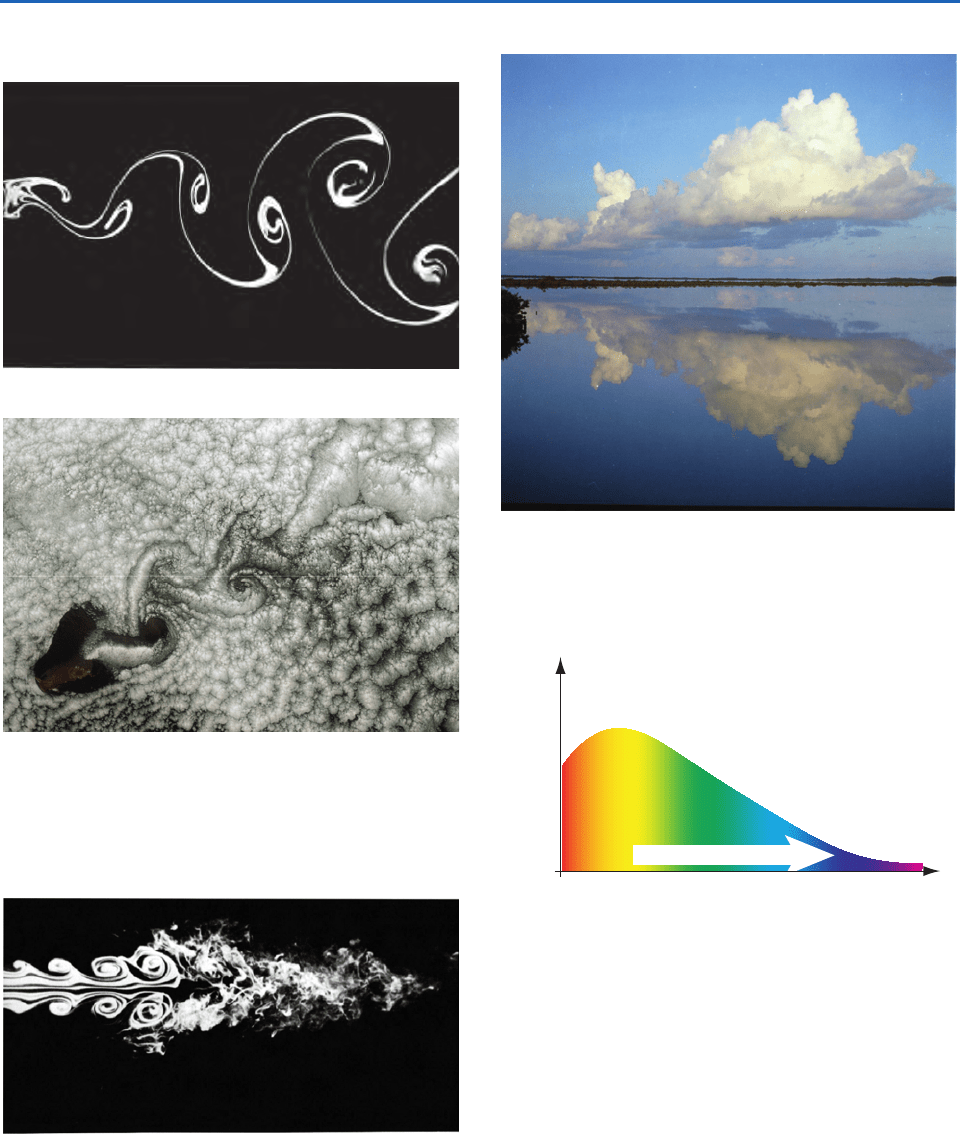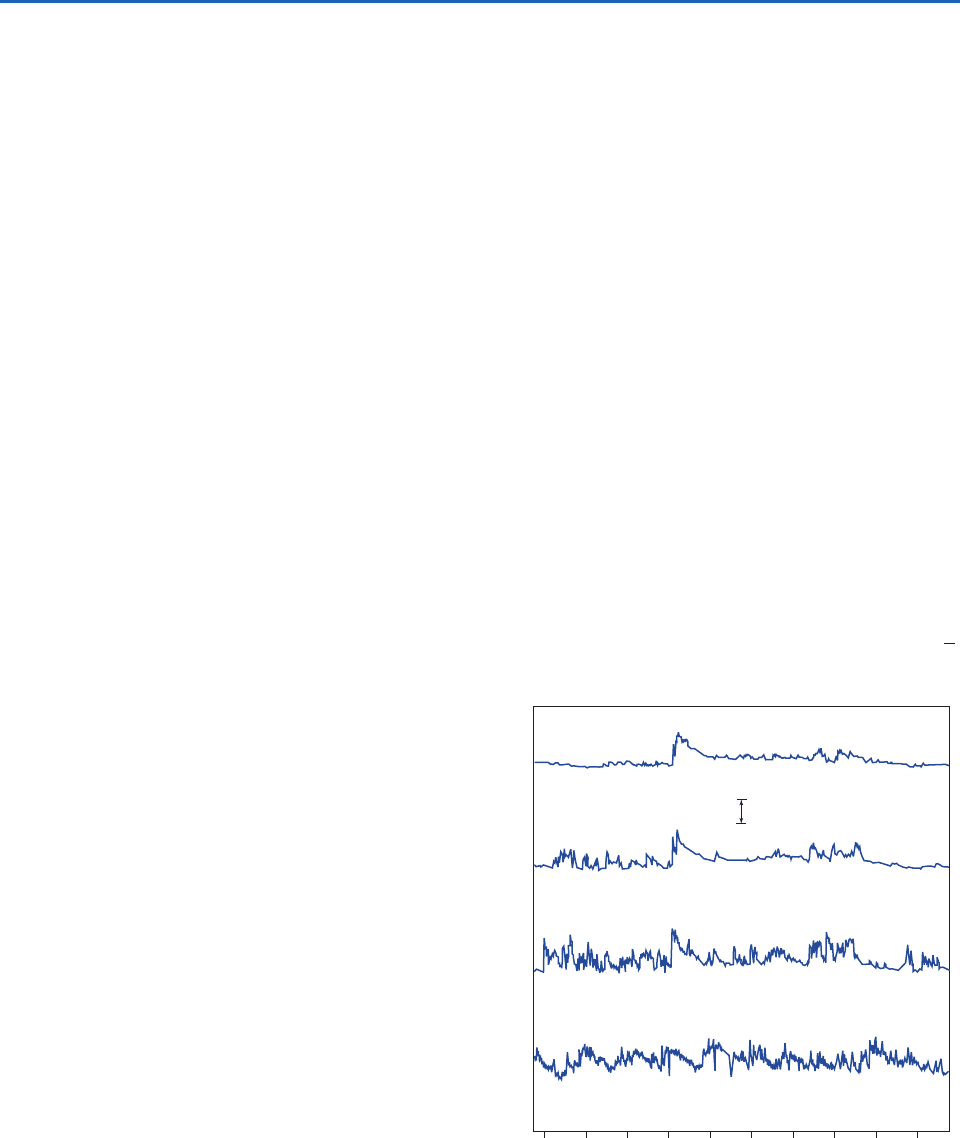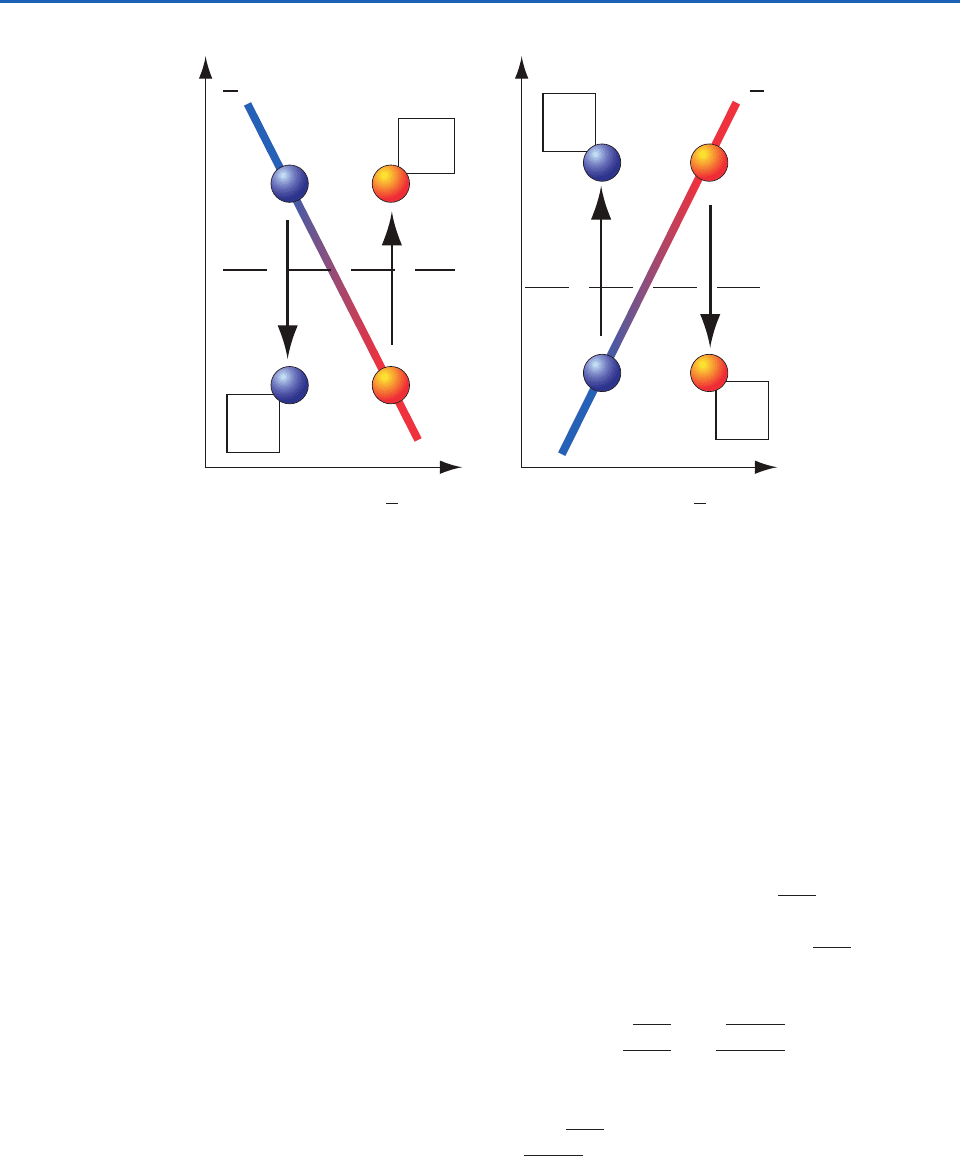Wallace J.M., Hobbs P.V. Atmospheric Science. An Introductory Survey
Подождите немного. Документ загружается.

P732951-Ch08.qxd 9/12/05 7:47 PM Page 374

The Earth’s surface is the bottom boundary of the
atmosphere. The portion of the atmosphere most
affected by that boundary is called the atmospheric
boundary layer (ABL, Fig. 9.1), or boundary layer for
short.The thickness of the boundary layer is quite vari-
able in space and time. Normally 1 or 2 km thick (i.e.,
occupying the bottom 10 to 20% of the troposphere), it
can range from tens of meters to 4 km or more.
Turbulence and static stability conspire to sand-
wich a strong stable layer (called a capping
inversion) between the boundary layer below and
the rest of the troposphere above (called the free
atmosphere). This stable layer traps turbulence, pol-
lutants, and moisture below it and prevents most of
the surface friction from being felt by the free
atmosphere.
During fair weather (associated with high-pressure
centers), we are accustomed to the diurnal (daily)
cycle of changes in temperature, humidity, pollen,
and winds that are governed by boundary-layer
physics and dynamics. It is cool and calm at night;
warm and gusty during daytime. The boundary layer
is said to be unstable whenever the surface is warmer
than the air, such as during a sunny day with light
winds over land, or when cold air is advected over a
warmer water surface. This boundary layer is in a
state of free convection, with vigorous thermal
updrafts and downdrafts. The boundary layer is said
to be stable when the surface is colder than the air,
such as during a clear night over land, or when warm
air is advected over colder water. Neutral boundary
layers form during windy and overcast conditions,
and are in a state of forced convection.
Turbulence is ubiquitous within the boundary
layer and is responsible for efficiently dispersing the
pollutants that accompany modern life. However, the
capping inversion traps these pollutants within the
boundary layer, causing us to “stew in our own
waste.” Turbulent communication between the sur-
face and the air is quite rapid, allowing the air to
quickly take on characteristics of the underlying sur-
face. In fact, one definition of the boundary layer is
that portion of the lower troposphere that feels the
effects of the underlying surface within about 30 min
or less.
Air masses
1
are boundary layers that form over
different surfaces. Temperature differences between
neighboring air masses cause baroclinicity that drives
extratropical cyclones. Heat and humidity trapped in
the boundary layer are important fuels for convec-
tive clouds. The capping inversion inhibits thunder-
storm formation, allowing the buildup of convective
available potential energy (CAPE) in the free atmos-
phere. Wind shear in the boundary layer, caused by
drag near the ground, generates horizontal vorticity
that can be tilted by the updrafts in convective clouds
to form tornadoes. Dissipation of kinetic energy
within the boundary layer serves as a brake on large-
scale wind systems.
Turbulence is inspiringly complex, consisting of a
superposition of swirls called eddies that interact
nonlinearly to create quasi-random, chaotic motions.
An infinite number of equations is required to fully
describe these motions. Hence, a complete solution
has not been found. But when averaged over
many eddies, we can observe persistent patterns
375
The Atmospheric Boundary
Layer
by Roland Stull
University of British Columbia,Vancouver, Canada
9
1
The term air mass refers to an expanse of air with distinctive properties that derive from its residence over a specific source region
and are still recognizable for some time after the air has moved into a different geographical setting. For example, air that has resided over
a high latitude continent during winter tends to be cold and dry.
P732951-Ch09.qxd 9/12/05 7:48 PM Page 375

376 The Atmospheric Boundary Layer
and similarities that can be measured and described.
In this chapter we explore the fascinating behavior
of the boundary layer and the turbulent motions
within it.
9.1 Turbulence
Atmospheric flow is a complex superposition of many
different horizontal scales of motion (Table 9.1),
where the “scale” of a phenomenon describes its typi-
cal or average size. The largest are planetary-scale
circulations that have sizes comparable to the circum-
ference of the Earth. Slightly smaller than planetary
scale are synoptic scale cyclones, anticyclones, and
waves in the jet stream. Medium-size features are
called mesoscale and include frontal zones, rain bands,
the larger thunderstorm and cloud complexes, and
various terrain-modulated flows.
Smaller yet are the microscales, which contain
boundary-layer scales of about 2 km, and the
smaller turbulence scales contained within it and
within clouds. The mesoscale and microscale are
further subdivided, as indicated in Table 9.1. This
chapter focuses on the microscales, starting with the
smaller ones.
9.1.1 Eddies and Thermals
When flows contain irregular swirls of many sizes
that are superimposed, the flow is said to be turbu-
lent. The swirls are often called eddies, but each
individual eddy is evanescent and quickly disap-
pears to be replaced by a succession of different
eddies. When the flow is smooth, it is said to be
laminar. Both laminar and turbulent flows can exist
at different times and locations in the boundary
layer.
Turbulence can be generated mechanically, ther-
mally, and inertially. Mechanical turbulence, also
known as forced convection, can form if there is
shear in the mean wind. Such shear can be caused by
frictional drag, which causes slower winds near the
ground than aloft; by wake turbulence, as the wind
swirls behind obstacles such as trees, buildings, and
islands (Fig. 9.2); and by free shear in regions away
from any solid surface (Fig. 9.3).
Thermal or convective turbulence, also known as
free convection, consists of plumes or thermals of
warm air that rises and cold air that sinks due to
buoyancy forces. Near the ground, the rising air
is often in the form of intersecting curtains or
sheets of updrafts, the intersections of which we can
identify as plumes with diameters about 100 m.
Higher in the boundary layer, many such plumes
and updraft curtains merge to form larger diameter
(1km) thermals. For air containing sufficient
moisture, the tops of these thermals contain cumu-
lus clouds (Fig. 9.4).
Small eddies can also be generated along the
edges of larger eddies, a process called the turbulent
cascade, where some of the inertial energy of the
larger eddies is lost to the smaller eddies, as elo-
quently described by Richardson’s poem (see
Chapter 1). Inertial turbulence is just a special form
of shear turbulence, where the shear is generated by
larger eddies. The superposition of all scales of eddy
motion can be quantified via an energy spectrum
(Fig. 9.5), which indicates how much of the total tur-
bulence kinetic energy is associated with each eddy
scale.
Table 9.1 Scales of horizontal motion in the atmosphere
Larger than Scale Name
20,000 km Planetary scale
2,000 km Synoptic scale
200 km Meso-
20 km Meso-
Mesoscale
2 km Meso-
200 m Micro-
Boundary-layer turbulence
20 m Micro-
Surface-layer turbulence
2 m Micro-
Inertial subrange turbulence
2 mm Micro-
Fine-scale turbulence
Air molecules Molecular Viscous dissipation subrange
C
a
p
p
i
n
g
I
n
v
e
r
s
i
o
n
B
o
u
n
d
a
r
y
L
a
y
e
r
Earth
Free Atmosphere
~11
km
~2
km
Troposphere
z
i
Height, z
Horizontal distance, x
Fig. 9.1 Vertical cross section of the Earth and troposphere
showing the atmospheric boundary layer as the lowest portion
of the troposphere. [Adapted from Meteorology for Scientists and
Engineers, A Technical Companion Book to C. Donald Ahrens’
Meteorology Today, 2nd Ed., by Stull, p. 65. Copyright
2000. Reprinted with permission of Brooks/Cole, a division
of Thomson Learning: www.thomsonrights.com. Fax 800-
730-22150.]
P732951-Ch09.qxd 9/12/05 7:48 PM Page 376

9.1 Turbulence 377
Turbulence kinetic energy (TKE) is not conserved.
It is continually dissipated into internal energy by
molecular viscosity. This dissipation usually happens
at only the smallest size (1 mm diameter) eddies, but
it affects all turbulent scales because of the turbulent
cascade of energy from larger to smaller scales. For
turbulence to exist, there must be continual genera-
tion of turbulence from shear or buoyancy (usually
into the larger scale eddies) to offset the transfer of
kinetic energy down the spectrum of ever-smaller
eddy sizes toward eventual dissipation. But why does
nature produce turbulence?
(b)
(a)
Fig. 9.2 Karman vortex streets in (a) the laboratory, for
water flowing past a cylinder [From M. Van Dyke, An Album of
Fluid Motion, Parabolic Press, Stanford, Calif. (1982) p. 56.],
and (b) in the atmosphere, for a cumulus-topped boundary
layer flowing past an island [NASA MODIS imagery].
Fig. 9.3 Water tank experiments of a jet of water (white) flow-
ing into a tank of clear, still water (black), showing the break-
down of laminar flow into turbulence. [Photograph by Robert
Drubka and Hassan Nagib. From M. Van Dyke, An Album of Fluid
Motion, Parabolic Press, Stanford, CA. (1982), p. 60.]
Fig. 9.4 Cumulus clouds fill the tops of (invisible) thermals
of warm rising air. [Photograph courtesy of Art Rangno.]
Turbulence Kinetic Energy
per eddy size
large eddies
(~2 km)
medium eddies
(~100 m)
small eddies
(~1 cm)
i
n
e
r
t
i
a
l
s
u
b
r
a
n
g
e
d
i
s
s
i
p
a
t
i
o
n
production
subrange
cascade of energy
Fig. 9.5 The spectrum of turbulence kinetic energy. By anal-
ogy with Fig. 4.2, the total turbulence kinetic energy (TKE) is
given by the area under the curve. Production of TKE is at the
large scales (analogous to the longer wavelengths in the elec-
tromagnetic spectrum, as indicated by the colors). TKE cas-
cades through medium-size eddies to be dissipated by
molecular viscosity at the small-eddy scale. [Courtesy of
Roland B. Stull.]
P732951-Ch09.qxd 9/12/05 7:48 PM Page 377

378 The Atmospheric Boundary Layer
Turbulence is a natural response to instabilities in
the flow—a response that tends to reduce the insta-
bility. This behavior is analogous to LeChatelier’s
principle in chemistry. For example, on a sunny day
the warm ground heats the bottom layers of air, mak-
ing the air statically unstable. The flow reacts to this
instability by creating thermal circulations, which
move warm air up and cold air down until a new
equilibrium is reached. Once this convective adjust-
ment has occurred, the flow is statically neutral and
turbulence ceases. The reason why turbulence can
persist on sunny days is because of continual destabi-
lization by external forcings (i.e., heating of the
ground by the sun), which offsets continual stabiliza-
tion by turbulence.
Similar responses are observed for forced turbu-
lence. Vertical shear in the horizontal wind is a
dynamic instability that generates turbulence. This
turbulence mixes the faster and slower moving air,
making the winds more uniform in speed and direc-
tion. Once turbulent mixing has reduced the shear,
then turbulence ceases. As in the case of convection,
persistent mechanical turbulence is possible in the
atmosphere only if there is continual destabilization
by external forcings, such as by the larger scale
weather patterns.
Although the human eye and brain can identify
eddies via pattern recognition, the short life span of
individual eddies renders them difficult to describe
quantitatively. The equations of thermodynamics
and dynamics described in Chapters 3 and 7 of
this book can be brought to bear on this problem,
but the result is an ability to deterministically simu-
late and predict the behavior of each eddy for
only exceptionally short durations. The larger diam-
eter thermals can be predicted out to about 15 min
to half an hour, but beyond that the predictive
skill approaches zero. For smaller eddies of order
100 m, the forecast skill diminishes after only a
minute or so. The smallest eddies of order 1 cm to
1 mm can be predicted out to only a few seconds.
This inability to deterministically forecast turbu-
lence out to useful periods of days is a result of
the highly non-linear nature of turbulent fluid
dynamics.
Despite the difficulties of deterministic descrip-
tions of turbulence, scientists have been able to cre-
ate a statistical description of turbulence. The goal
of this approach is to describe the net effect of
many eddies, rather than the exact behavior of any
individual eddy.
9.1.2 Statistical Description of Turbulence
When fast-response velocity and temperature sensors
are inserted into turbulent flow, the net effect of the
superposition of many eddies of all sizes blowing past
the sensor are temperature and velocity signals that
appear to fluctuate randomly with time (Fig. 9.6).
However, close examination of such a trace reveals
that for any half-hour period, there is a well-defined
mean temperature and velocity; the range of temper-
ature and velocity fluctuations measured is bounded
(i.e., no infinite values); and a statistically robust stan-
dard deviation of the signal about the mean can be
calculated. That is to say, the turbulence is not com-
pletely random; it is quasi-random.
Suppose that the velocity components (u, v, w) are
sampled at regular time intervals t and then digitized
and recorded on a computer to form a time series
(9.1)
where i is the index of the data point (corresponding to
time t it) for i 1 to N in a time series of duration
T N t. The u-component of the mean wind ,u
u
i
u (i t)
Time (s)
Temperature
1°
16 m
0.5
m
2 m
4
m
0906030
Fig. 9.6 Simultaneous time series of temperature (°C) at
four heights above the ground showing the transition from the
surface layer (bottom 5–10% of the mixed layer) toward the
mixed layer boundary layer (upper levels of the boundary layer).
Observations were taken over flat, plowed ground on a clear
day with moderate winds. The top three temperature sensors
were aligned in the vertical; the 0.5 m sensor was located 50 m
away from the others. [Courtesy of J. E. Tillman.]
P732951-Ch09.qxd 9/12/05 7:48 PM Page 378

9.1 Turbulence 379
based on an average over a time period T (say half an
hour), is thus
(9.2)
In the atmosphere, this mean value can change from
one half-hour period to the next, resulting in a slow
variation of the mean-wind components with time. The
velocities referred to in Chapters 7 and 8 are mean
velocities (namely, the gusts are averaged out), even
though the overbar was not shown. Also, Eq. (9.2) can
be generalized: 1N times the sum of N samples of any
variable is the average of those samples, and can be
indicated by an overbar [e.g., Eq. (9.4)].
Subtracting the mean from the instantaneous com-
ponent u
i
gives just the fluctuating (gust) portion of
the flow (indicated with a prime)
(9.3)
which varies rapidly with time. The intensity of tur-
bulence in the u direction is then defined by the
variance
2
(9.4)
Again, this is the variance averaged over a half-hour
period so this variance value can vary slowly with time
over subsequent averaging periods. Similar equations
can be defined for the other velocity components.
For situations in which
u
2
is relatively constant with
time (e.g., the same now as an hour ago), the turbulent
nature of the flow is said to be stationary. When
u
2
is
relatively uniform in space (e.g., the same value in one
town as in a neighboring town), the flow is said to be
homogeneous. For situations in which the turbulence
intensity at any one point is the same in all directions
(
u
2
v
2
w
2
), the flow is said to be isotropic.
In the atmosphere, fluctuations in velocity are often
accompanied by fluctuations in scalar values such as
temperature, humidity, or pollutant concentration. For
example, in a field of thermals there are regions where
warm air is rising (positive potential temperature
accompanies positive vertical velocity w), surrounded
by regions where cold air is sinking (negative
accom-
2
u
1
N
N
i1
[u
i
u]
2
1
N
N
i1
[u
i
]
2
[u]
2
u
i
u
i
u
u
1
N
N
i1
u
i
panies negative w). One measure of the amount that
and w vary together is the covariance (cov)
(9.5)
If warm air parcels are rising and cold parcels are
sinking, as in a thermally direct circulation, then
. Covariances can also be negative or zero
for different situations in the atmosphere.
The power of the statistical approach is that the
velocity variance is more than just a statistic—it
represents the kinetic energy associated with the
motions on the scale of the turbulence. Similarly,
the covariance is a measure of flux due to these
motions, such as the vertical heat flux in Eq. (9.5).
Such interpretations are explained next.
9.1.3 Turbulence Kinetic Energy
and Turbulence Intensity
Recall from basic physics that kinetic energy is
, where m is mass and V is velocity. In
meteorology we often use specific kinetic energy,
namely KE
m, or the kinetic energy per unit mass.
By extension, we can focus on just the portion of
specific kinetic energy associated with turbulent
fluctuations
or, using (9.4),
(9.6)
where TKE is turbulence kinetic energy. For laminar
flow, which contains no microscale motions, TKE 0,
even though , , are not necessarily zero. Larger
values of TKE indicate a greater intensity of the
microscale turbulence. We see now that the three
components of velocity variance represent three con-
tributions to the scalar TKE.
wvu
TKE
m
1
2
[
2
u
2
v
2
w
]
TKE
m
1
2
[
u
2
v
2
w
2
]
KE
1
2
mV
2
w
0
1
N
N
i1
[(w
i
) (
i
)] w
cov (w,
)
1
N
N
i1
[(w
i
w) (
i
)]
2
Although this is the “biased” variance in statistics terminology, it is negligibly different from the unbiased variance because N is typi-
cally very large—1000 or more. The unbiased variance uses N 1 instead of N in the denominator of Eq. (9.4).
P732951-Ch09.qxd 9/12/05 7:48 PM Page 379

380 The Atmospheric Boundary Layer
Using what we already know about mechanical
and thermal generation of turbulence, and of viscous
dissipation, we can write in descriptive form an
Eulerian (i.e., fixed relative to the ground) forecast
equation for turbulence kinetic energy:
(9.7)
where
is the advection of TKE by the mean wind, M is
mechanical generation of turbulence, B is buoyant
generation or consumption of turbulence, Tr is trans-
port of turbulence energy by turbulence itself, and
is the viscous dissipation rate. The terms Ad and Tr
neither create nor destroy TKE, they just redistribute
it by moving it from one location to another. M is
usually positive (or zero if there is no shear) and
therefore generates turbulence, while B can be posi-
tive or negative. Dissipation is always negative and
can be approximated by (TKE
m)
32
L
, where
L
is a dissipation length scale.
In the absence of the terms Ad, M, B, and Tr,we
see that as long as TKE is nonzero, the last term will
always cause TKE to decrease toward zero. For this
reason, turbulence is said to be dissipative.
In statically stable environments the buoyancy
term can reduce TKE by converting it to potential
energy by moving cold air up and warm air down. In
such situations, the existence of turbulence depends
on the relative strengths of mechanical generation
(M) by wind shear versus buoyant consumption (B)
by static stability. The ratio of these two terms
defines the dimensionless Richardson number, Ri,
which can be approximated by the vertical gradients
of wind and potential temperature
(9.8)
where the term in the numerator is equivalent to the
square of the Brunt Väisälä frequency, as defined in
Ri
B
M
T
v
v
z
u
z
2
v
z
2
w
(TKE
m)
z
Ad u
(TKE
m)
x
v
(TKE
m)
y
(TKE
m)
t
Ad M B Tr
(3.75). Laminar flow becomes turbulent when Ri
drops below the critical value Ri
c
0.25. Turbulent
flow often stays turbulent, even for Richardson num-
bers as large as 1.0, but becomes laminar at larger
values of Ri. The presence or absence of turbulence
for 0.25 Ri 1.0 depends on the history of the
flow: a behavior analogous to hysteresis. Flows for
which Ri
c
0.25 are said to be dynamically unstable.
When the shear in laminar flow across a density
interface (e.g., between cold air below and warm air
above) increases to the point at which the flow
becomes dynamically unstable, the turbulence onset
grows as a Kelvin-Helmholtz (KH) instability on the
interface. First, small waves appear that grow in ampli-
tude and curl over on themselves. If sufficient mois-
ture is present in the atmosphere, a cloud can form in
the rising portions of each curl, giving rise to a pattern
that looks like breaking waves at the beach when
viewed from the side (Fig. 9.7a). When viewed from
above or below, these features appear as closely
spaced parallel bands of clouds, called KH billows or
billow clouds (Fig. 9.7b), which are perpendicular to
the vertical shear vector
V
z. The overturning of
the billows introduces static instabilities (i.e., locally
unstable lapse rates) that further accelerate the transi-
tion to turbulence within the shear layer.
The shapes of turbulent eddies are also modulated
by the static stability. Under statically unstable condi-
tions with rising thermals, the largest eddies are
strongly anisotropic, with much greater turbulent
energy in the vertical motion component than in the
horizontal component. For continuous emissions of
smoke from a smoke stack, smoke plumes loop up
and down and spread more rapidly in the vertical
than in the horizontal. Under statically neutral condi-
tions, turbulence is almost isotropic, and smoke
plumes spread equally in the vertical and in the hori-
zontal, yielding a conical envelope, a behavior
referred to as coning. When the flow is statically sta-
ble but dynamically unstable, the vertical component
of turbulence is partly suppressed by the negative
buoyancy of the rising air and the positive buoyancy
of the sinking air—a process referred to as buoyant
consumption—resulting in anisotropy with moderate
TKE in the horizontal motion component but very
little energy in the vertical component. Smoke
plumes in such an environment fan out horizontally.
In extremely stable conditions, turbulence is com-
pletely suppressed, and smoke blows downwind with
almost no dispersion, although the plume centerline
can oscillate up and down as a laminar wave.
P732951-Ch09.qxd 9/12/05 7:48 PM Page 380

9.1 Turbulence 381
9.1.4 Turbulent Transport and Fluxes
Covariances can be interpreted as fluxes using the fol-
lowing concepts. Consider a portion of the atmosphere
with a constant gradient of potential temperature, as
sketched in Fig. 9.8. Consider an idealized eddy circula-
tion consisting of an updraft portion that moves an air
parcel from the bottom to the top of the layer, and a
compensating downdraft that moves a different air par-
cel downward. Air mass is conserved (i.e., mass up
mass down). However, the air parcels carry with them
small portions of the air from their starting points, and
these portions preserve their potential temperatures as
they move, resulting in a flux as will now be shown.
In Fig. 9.8a, the thick line represents a statically
unstable mean environment [ (z)]. For this case when
the rising air parcel reaches its destination, its poten-
tial temperature is warmer than the surrounding envi-
ronment at that altitude. Namely, its deviation from
its new environment is
().This air parcel had to
move upward to get to its destination so w().
The contribution of this rising parcel to the total
covariance is w times
w
() () ().
Similarly, for the downward-moving [w()] por-
tion of this eddy, the cold air from aloft finds itself
colder [
()] than its new surrounding environ-
ment at its final low altitude. Thus, its contribution to
the covariance is w
() () ().
The average of these two air parcels represents the
covariance, and since each contribution is positive,
the average (indicated by the overbar) is also posi-
tive: . Thus, positive covariance is
associated with warm air moving up andor cold air
moving down, namely a positive heat flux .
This form of flux is called a kinematic heat flux and
has units of (K m s
1
). It is related to the traditional
heat flux Q
H
(W m
2
) by
(9.9)
where
is the mean air density and c
p
is the specific
heat of air at constant pressure.
Figure 9.8b shows the contrasting behavior
observed in a statically stable environment. In this
case, both the upward and downward moving parcels
contribute negatively to the covariance. Thus, a
downward heat flux is associated with cold air mov-
ing up or warm air moving down. Hence, the covari-
ance is negative.
These fluxes can contribute to the warming and
cooling of layers of air via the first law of thermody-
namics (see Chapter 3), which, in the absence of
other heat sources, can be rewritten as
(9.10)
Note also the analogy with radiative fluxes in the
expression for radiative heating rates (4.52).
The net result of this turbulence is that warmer
and colder layers are mixed to yield an intermediate
potential temperature. In a similar manner, one can
t
w
z
F
H
w
Q
H
c
p
F
H
c
p
w
F
H
(w
)
w
w
()
(a1)
(a)
(a2)
Fig. 9.7 (a) Kelvin–Helmholtz waves (b) Kelvin–Helmholtz
billows in clouds. Kelvin–Helmholtz (KH) breakdown of shear
flow. (al) A long narrow water tank is filled with a layer of salt
brine (dyed a dark color) in the bottom half and clear, fresh
water in the top half. When the tank is tilted, the heavy brine
flows downslope (to the left in this photo) and the lighter
fresh water flows upslope, creating a shear across the density
interface. [From J. Fluid Mech., 46 (1971) p. 299, plate 3.]
(a2) Similar breaking of KH waves at an atmospheric density
interface, by chance made visible by clouds. [Courtesy of
Brooks Martner.] (b) KH billow clouds in the atmosphere as
viewed from above. [NASA MODIS imagery.]
(b)
P732951-Ch09.qxd 9/12/05 7:48 PM Page 381

382 The Atmospheric Boundary Layer
conceive of turbulent mixing of moisture, pollutants,
and even momentum. In each case, turbulence tends
to homogenize a fluid.
Turbulence is an extremely efficient mixer. For
example, when milk is added to coffee or tea, most
people prefer not to wait hours for molecular diffu-
sion to homogenize their drink. Instead, they stir the
fluid to generate turbulence, which homogenizes their
drink within a few seconds. Atmospheric turbulence is
equally efficient at causing mixing—so much so that
molecular diffusion and molecular viscosity can be
neglected for all motions except the tiniest eddies. In
fact, during the daytime over land, convective turbu-
lence is so effective at mixing that the boundary layer
is also known as the mixed layer because pollutants
are distributed so quickly in the vertical.
9.1.5 Turbulence Closure
Equation (9.10) is a forecast equation for potential
temperature. The overbar on all the terms in this
equation is associated with a process called Reynolds
averaging—an applied mathematical method that
eliminates small linear terms such as those associated
with nonbreaking waves, but retains the non-linear
terms associated with, or affected by, turbulence.
There are many other terms that appear on the right-
hand side of the full Reynolds-averaged forecast
equation, but for now we will focus on just the heat-
flux divergence term. To forecast how the mean
potential temperature will change with time, we need
to know the kinematic heat flux .
A Reynolds-averaged forecast equation can also
be derived for kinematic heat flux , which is of
the form
(9.11)
This new equation yields a forecast of the second-order
statistic , but it introduces a new third-order statis-
tic , which is the turbulent flux of a heat flux. If
we write a forecast equation for this third-order statis-
tic, we introduce even higher order unknowns.
This is the turbulence closure problem. Mathematically
speaking, the equations are not closed. There are
always more unknowns than equations. In other
words, we need an infinite number of equations to
describe turbulence, even if we want only to forecast
the mean potential temperature.
ww
w
w
t
ww
z
w
w
(a) Statically unstable: ∂θ/∂z < 0.
w ′θ ′
= (+)
w ′θ ′
= (+)
}
}
1
2
w
′ = (+)w ′ = (–)
1
2
θ ′ = (+)
θ ′ = (–)
θθ
Potential Temperature, θ
(b) Statically stable: ∂θ/∂z > 0.
w ′θ ′
= (–)
w ′θ ′
= (–)
}
}
w ′ = (–)w ′ = (+)
1
2 1
2
θ ′ = (+)
θ ′ = (–)
Potential Temperature, θ
Height,
z
Height,
z
Fig. 9.8 Illustration of how to anticipate the sign of turbulent heat fluxes for small-eddy (local) vertical mixing across a region with
a linear gradient in the mean potential temperature
(thick colored line). Assuming an adiabatic process (no mixing), air parcels
(sketched as spheres) preserve their potential temperature (as indicated by their color) of the ambient environment at their starting
points (1), even as they arrive at their destinations (2). (a) Statically unstable lapse rate. (b) Statically stable lapse rate. [Adapted
from Meteorology for Scientists and Engineers, A Technical Companion Book to C. Donald Ahrens’ Meteorology Today, 2nd Ed., by Stull,
p. 87. Copyright 2000. Reprinted with permission of Brooks/Cole, a division of Thomson Learning: www.thomsonrights.com Fax
800-730-2215.]
P732951-Ch09.qxd 9/12/05 7:48 PM Page 382

9.1 Turbulence 383
To mitigate this difficulty, we can make closure
assumptions. Namely, we can retain a finite number
of equations and then approximate the remaining
unknowns as a function of the knowns. The resulting
parameterization will not give a perfect answer, but it
will give an approximate answer that often is good
enough.
Turbulence closure assumptions are categorized
both by their statistical order and by the amount of
nonlocalness that is included. For the statistical
order, if we keep Eq. (9.10) and approximate the
unknown as a function of the known variables,
the result is called first-order closure, named after the
highest order forecast equation retained. Second-
order closure retains both Eqs. (9.10) and (9.11) and
parameterizes the third-order statistics .
A common local, first-order closure is called
gradient-transfer theory, K-theory, eddy-diffusivity
theory, or mixing-length theory. Analogous to molec-
ular diffusion, it assumes that the flux is linearly pro-
portional to and directed down the local gradient, i.e.,
(9.12)
where an eddy diffusivity, K, is used instead of the
molecular diffusivity. The parameter K is prescribed
to increase with the intensity of the turbulence,
which varies with height above ground, mean wind
shear, and surface heating by the sun. Prandtl’s
3
mixing length approach was one of the first parame-
terizations for eddy diffusivity: K l
2
s
V
zs,
where V is mean horizontal wind speed and
represents an average size or mixing
length for the eddies. The parameter l is often
approximated by l kz in the surface layer
(the bottom 5 to 10% of the boundary layer), where
k 0.4 is the von Karman
4
constant and z is height
above ground level. The wind-shear term in K para-
meterizes the effects of mechanical generation of
turbulence.
l
(
z
2
)
1
2
F
H
w
K
dz
ww
w
The closure in Eq. (9.12) is a local closure in the
sense that the heat flux at any altitude depends on
the local gradient of potential temperature at that
same altitude. Namely, it implicitly assumes that only
small-size eddies exist. Similar first-order closures
can be written for moisture, pollutant, and momen-
tum fluxes.
While local first-order closures often work nicely in
laboratory settings, they frequently fail in the unstable
atmospheric boundary layer. Under these conditions,
thermals cause such intense mixing and homogeniza-
tion as to eliminate the vertical gradient of mean
potential temperature in the middle of the boundary
layer, yet there are strong positive heat fluxes caused
by the rising thermals. For this situation, nonlocal first-
order closures have been developed, where the flux
across any one altitude depends on transport by all
eddy sizes, including the large eddies that move
heated air from just above the Earth’s surface all the
way to the top of the boundary layer.
Finally, a large body of useful results have been
complied for statistical zeroth-order closure. In this
case, neither Eqs. (9.10) nor (9.11) is retained. Instead,
the mean flow state is parameterized directly. This
approach, called similarity theory, is illustrated in the
next subsection.
9.1.6 Turbulence Scales and Similarity
Theory
Some zero and first-order closure schemes rely on
simple empirical
5
relationships derived from dimen-
sional analysis. Variables that frequently appear in
combination with one another are grouped to form
new variables that may be nondimensional, such as
the Richardson number defined in Eq. (9.8), or may
have simple dimensional units such as velocity,
length, or time that in some cases relate to the most
important scales of motion in the eddies.
A velocity scale that is useful for characterizing
the turbulent mixing due to free convection in an
3
Ludwig Prandtl (1874–1953) German aerodynamicist and accomplished pianist. Developed theories for the boundary layer, airfoils,
lift vs. drag, and supersonic flow for rocket nozzles. Educated in Munich in mechanics, became professor in Hannover, and later directed
the Institute for Technical Physics and the Kaiser Wilhelm Institute for Flow Investigation, University of Göttingen, Germany.
4
Theodor von Kármán (1881–1963) Hungarian aerodynamicist, specializing in supersonic flight. Studied boundary layers and airfoils
under Ludwig Prandtl and became professor of aeronautics and mechanics at the University of Aachen, Germany. Worked with Hugo
Junkers to help design the first cantilevered wing all metal airplane in 1915. Became director of the Guggenheim Aeronautical Lab at the
California Institute of Technology, advancing theoretical aerodynamics and rocket design, and spawning the Jet Propulsion Lab. Was the
first recipient of the U.S. National Medal of Science, awarded by John F. Kennedy.
5
Based on observed relationships between variables.
P732951-Ch09.qxd 9/12/05 7:48 PM Page 383
